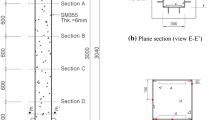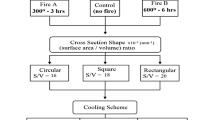Abstract
The present research work is carried out to investigate the effect of cover, temperature, and fire duration on the residual load carrying capacity of unstressed Reinforced Concrete (RC) columns exposed to fire. Experiments were conducted at increased temperatures of 300,500, and 800 °C on 150 × 150 mm RC columns with an L/D ratio of 4, concrete covers of 20,30, and 40 mm, and fire durations of F30 (0.5 h), F60 (1.0 h), F90 (1.5 h), and F120 (2.0 h). Additionally, the residual compressive strength of plain concrete (same batch mix of columns) was evaluated after being exposed to similar fire durations. At all temperatures and fire durations, the percentage residual load carrying capacity of 30 and 40 mm cover columns is almost identical. The residual load carrying capacity decreased with the increase in the temperature. Maximum loss occurred at 800 °C, the loss being 28.10%, 36.15%, 44.69% and 55.34% at 0.5, 1.0, 1.5 and 2.0 h respectively in columns with 40 mm cover. The results of compressive strength of concrete are in good agreement with the column results.








Similar content being viewed by others
References
Bikhiet M, El-Shafey NF, El-Hashimy HM (2014) Behavior of reinforced concrete short columns exposed to fire. Alex Eng J 53:643–653. https://doi.org/10.1016/j.aej.2014.03.011
Abrams MS (1977) Compressive strength of concrete at temperatures to 1600F fire. PCA Res Dev Bull. https://doi.org/10.14359/17331
Phan LT (1996) Fire performance of high strength concrete. A report of the state of the art. National Institute of Standards and Technology, Gaithersburg
Purkiss AJ (2007) Fire safety engineering design of structures, 2nd ed
Hertz KD (2005) Concrete strength for fire safety design. Mag Concr Res 57(8):445–453. https://doi.org/10.1680/macr.2005.57.8.445
Yaqub M, Bailey CG (2016) Non-destructive evaluation of residual compressive strength of post-heated reinforced concrete columns. Constr Build Mater 120:482–493. https://doi.org/10.1016/j.conbuildmat.2016.05.022
Mohd Zahid MZA, Abu Bakar BH, Muhamad Nazri F (2006) Behaviour of post heated reinforced concrete columns. IOP Conf Ser. https://doi.org/10.1088/17551315/244/1/012006
Shariq M, Masood A, Umar A, Masroor Alam M, Haiyan A (2020) Residual load carrying capacity of reinforced concrete cylinders after heating at elevated temperature. SN Appl Sci 2:1671. https://doi.org/10.1007/s42452-02003483-7
Balaji A, Muhamed Luquman K, Nagarajan P, Madhavan Pillai TM (2016) Studies on the behavior of reinforced concrete short column subjected to fire. Alex Eng J 55:475–486. https://doi.org/10.1016/j.aej.2015.12.02
Funding
The authors did not receive support from any organization for the submitted work. No funding was received to assist with the preparation of this manuscript. No funding was received for conducting this study. No funds, grants, or other support was received. The authors have no relevant financial or non-financial interests to disclose. The authors have no competing interests to declare that are relevant to the content of this article. All authors certify that they have no affiliations with or involvement in any organization or entity with any financial interest or non-financial interest in the subject matter or materials discussed in this manuscript. The authors have no financial or proprietary interests in any material discussed in this article.
Author information
Authors and Affiliations
Corresponding author
Ethics declarations
Conflict of interest
The authors have not disclosed any competing interests.
Ethical approval
This is an observational study. This study was reviewed and deemed exempt by our GITAM institutional Review Board.
Consent to participate and/or consent to publish
Obtaining consent of anyone is not required for this study.
Additional information
Publisher's Note
Springer Nature remains neutral with regard to jurisdictional claims in published maps and institutional affiliations.
Rights and permissions
Springer Nature or its licensor holds exclusive rights to this article under a publishing agreement with the author(s) or other rightsholder(s); author self-archiving of the accepted manuscript version of this article is solely governed by the terms of such publishing agreement and applicable law.
About this article
Cite this article
Eranki, B., Malasani, P. Residual load carrying capacity of un-stressed RC columns under fire. J Build Rehabil 7, 95 (2022). https://doi.org/10.1007/s41024-022-00227-5
Received:
Revised:
Accepted:
Published:
DOI: https://doi.org/10.1007/s41024-022-00227-5




